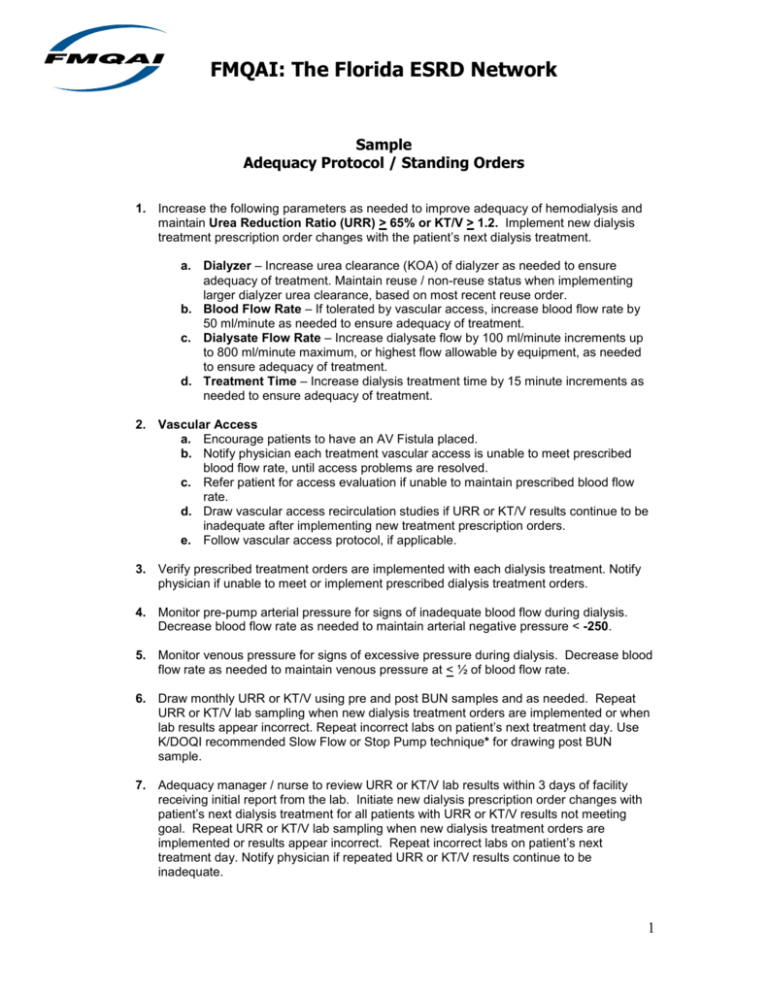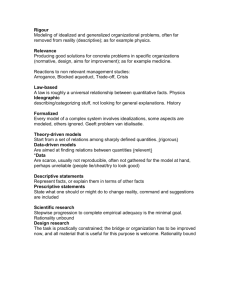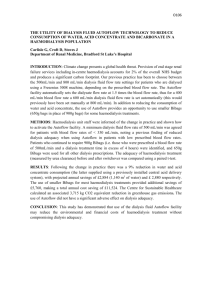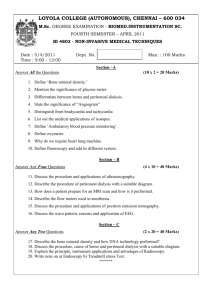Adequacy Protocol
advertisement

FMQAI: The Florida ESRD Network Sample Adequacy Protocol / Standing Orders 1. Increase the following parameters as needed to improve adequacy of hemodialysis and maintain Urea Reduction Ratio (URR) > 65% or KT/V > 1.2. Implement new dialysis treatment prescription order changes with the patient’s next dialysis treatment. a. Dialyzer – Increase urea clearance (KOA) of dialyzer as needed to ensure adequacy of treatment. Maintain reuse / non-reuse status when implementing larger dialyzer urea clearance, based on most recent reuse order. b. Blood Flow Rate – If tolerated by vascular access, increase blood flow rate by 50 ml/minute as needed to ensure adequacy of treatment. c. Dialysate Flow Rate – Increase dialysate flow by 100 ml/minute increments up to 800 ml/minute maximum, or highest flow allowable by equipment, as needed to ensure adequacy of treatment. d. Treatment Time – Increase dialysis treatment time by 15 minute increments as needed to ensure adequacy of treatment. 2. Vascular Access a. Encourage patients to have an AV Fistula placed. b. Notify physician each treatment vascular access is unable to meet prescribed blood flow rate, until access problems are resolved. c. Refer patient for access evaluation if unable to maintain prescribed blood flow rate. d. Draw vascular access recirculation studies if URR or KT/V results continue to be inadequate after implementing new treatment prescription orders. e. Follow vascular access protocol, if applicable. 3. Verify prescribed treatment orders are implemented with each dialysis treatment. Notify physician if unable to meet or implement prescribed dialysis treatment orders. 4. Monitor pre-pump arterial pressure for signs of inadequate blood flow during dialysis. Decrease blood flow rate as needed to maintain arterial negative pressure < -250. 5. Monitor venous pressure for signs of excessive pressure during dialysis. Decrease blood flow rate as needed to maintain venous pressure at < ½ of blood flow rate. 6. Draw monthly URR or KT/V using pre and post BUN samples and as needed. Repeat URR or KT/V lab sampling when new dialysis treatment orders are implemented or when lab results appear incorrect. Repeat incorrect labs on patient’s next treatment day. Use K/DOQI recommended Slow Flow or Stop Pump technique* for drawing post BUN sample. 7. Adequacy manager / nurse to review URR or KT/V lab results within 3 days of facility receiving initial report from the lab. Initiate new dialysis prescription order changes with patient’s next dialysis treatment for all patients with URR or KT/V results not meeting goal. Repeat URR or KT/V lab sampling when new dialysis treatment orders are implemented or results appear incorrect. Repeat incorrect labs on patient’s next treatment day. Notify physician if repeated URR or KT/V results continue to be inadequate. 1 8. Evaluate Residual Renal function with urea clearance (KRU) from 24-hour urine collection and review with physician at least every six months. 9. Notify Charge Nurse and re-educate patients requesting to discontinue dialysis treatment early. Encourage patients to complete entire dialysis treatment time. 10. Adequacy manager to review facility adequacy results at monthly Quality Improvement Committee meetings. Initiate a facility adequacy improvement plan if facility overall URR or KT/V results show <80% of patients are receiving adequate treatment. 11. Review the adequacy improvement plan monthly, document evaluation of the adequacy plan and implement new strategies and action steps as needed to replace those that are ineffective. 12. Develop a patient specific care plan to address barriers and issues impacting adequacy results for all patients not meeting adequacy goals. Review this plan of care with the patient and all of the patient’s care givers. _______________________________________ Physician Signature _______________________________________ Date _______________________________________ RN Signature _______________________________________ Date * see Strategies for Improving Adequacy in the Florida ESRD Network Adequacy Toolkit and K/DOQI Guidelines 2






